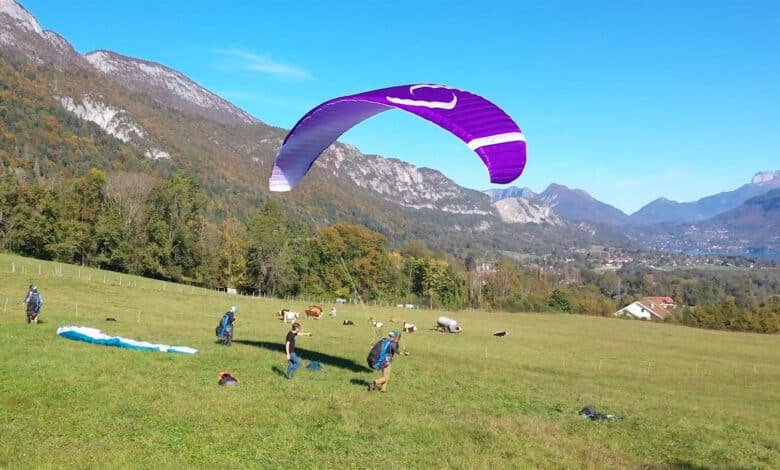How to Learn Paragliding: Your Ultimate Guide

How to Learn Paragliding: Your Ultimate Guide Paragliding is one of the most thrilling ways to experience flight. Imagine gliding over stunning landscapes, feeling the wind against your face, and enjoying the freedom of the skies. If you’re interested in learning paragliding, you’re in the right place. This guide will cover everything you need to know to get started on your paragliding journey.
What is Paragliding?
Paragliding is a form of free flight. You use a lightweight, free-flying wing to glide through the air. Unlike a powered aircraft, a paraglider relies on air currents to stay aloft. This allows for a unique flying experience that is both exhilarating and peaceful.
Why Choose Paragliding?
There are many reasons to learn paragliding:
- Sense of Freedom: There’s nothing like soaring through the air.
- Adventure: Explore new locations from above.
- Community: Connect with fellow enthusiasts.
- Stress Relief: Experience tranquility high above the ground.
Steps to Learning Paragliding
1. Understand the Basics
Before you jump into lessons, take some time to learn the basics of paragliding. Familiarize yourself with the terminology and equipment.
- Canopy: The wing that provides lift.
- Harness: The seat that holds the pilot.
- Lines: Cords that connect the canopy to the harness.
- Variometer: A device that measures altitude changes.
2. Choose a Reputable School
Finding the right paragliding school is crucial for your safety and success. Look for:
- Certification: Make sure the school is accredited by a recognized body.
- Qualified Instructors: Check their experience and qualifications.
- Positive Reviews: Read testimonials from past students.
3. Start with an Introductory Course
Most paragliding schools offer an introductory course. This usually includes:
- Ground Handling: Learn to control your wing on the ground.
- Theory Lessons: Understand the principles of flight and safety.
- First Flight: Experience a tandem flight with an instructor.
4. Enroll in a Beginner Course
After your introductory experience, sign up for a beginner course. This course typically covers:
- Advanced Ground Handling: Gain more control over your wing.
- Solo Flights: Start flying solo from small hills.
- Safety Practices: Learn essential safety protocols.
5. Practice Regularly
Like any skill, paragliding requires practice. Try to fly as often as possible. Join group flights to enhance your skills and learn from others. The more you fly, the more confident you will become. How to Learn Paragliding: Your Ultimate Guide
6. Get Certified
Once you feel comfortable flying, aim for certification. Certification involves:
- Skill Evaluation: Demonstrate your flying skills to an instructor.
- Written Exam: Test your knowledge of theory and safety.
Certification allows you to fly independently and access more flying sites.
7. Invest in Your Equipment
Once you’re serious about paragliding, consider investing in your own gear. Essential equipment includes:
- Wing: Choose a wing suitable for your skill level.
- Harness: Look for comfort and safety features.
- Helmet: Always wear a helmet for protection.
- Variometer: This tool helps you track your altitude.
8. Join the Paragliding Community
Connecting with other paragliders can enrich your experience. Join local clubs or online forums. Share tips, experiences, and advice. Community support is invaluable in your learning journey.
9. Continue Your Education
Paragliding is a sport where learning never stops. Consider:
- Advanced Courses: Explore cross-country flying or acrobatics.
- Workshops: Attend sessions on navigation and weather.
- Mentorship: Seek guidance from experienced pilots.
10. Prioritize Safety
Safety should always be your top priority. Follow these tips:
- Pre-flight Checks: Always inspect your gear before flying.
- Weather Awareness: Understand how weather affects flying conditions.
- Emergency Preparedness: Know how to handle emergencies.
Essential Tips for Success
- Stay Fit: Physical fitness will enhance your flying ability.
- Be Patient: Learning to fly takes time. Progress at your own pace.
- Keep a Positive Attitude: Celebrate small achievements and learn from setbacks.
Understanding Weather Conditions
Weather plays a significant role in paragliding. Here are some factors to consider:
Wind
- Takeoff: A headwind is ideal for takeoff. It helps lift the wing.
- Flying: Light winds are best for beginners. Avoid strong gusts.
Thermals
Thermals are upward currents of warm air. They help you gain altitude. Learning to identify thermals can enhance your flying experience.
Cloud Cover
Avoid flying in cloudy conditions, especially if you’re a beginner. Clouds can obscure visibility and make navigation challenging.
Common Challenges in Learning Paragliding
Every new pilot faces challenges.
Fear of Heights
Many beginners experience fear when first flying. Take gradual steps to build your confidence. Start with small flights and progress at your own pace.
Equipment Handling
Learning to manage your equipment can be daunting. Practice ground handling extensively. Familiarity with your gear will boost your confidence.
Weather Anxiety
Understanding weather conditions takes time. Consult with your instructor and study weather patterns. Knowledge will reduce anxiety about flying.
The Joy of Flying
Once you overcome the initial hurdles, paragliding becomes an incredibly rewarding experience. The feeling of gliding through the air, surrounded by breathtaking scenery, is unmatched.
The Freedom of Flight
Paragliding offers a sense of freedom that few activities can match. You can explore different locations and enjoy nature from a unique perspective.
Connecting with Nature
Flying allows you to connect with nature in a profound way. Experience stunning views, observe wildlife, and feel the elements around you.
Lifelong Adventure
Learning paragliding opens the door to a lifelong adventure. As you gain experience, you can explore new flying sites, take on challenges, and even participate in competitions.
Conclusion
Learning paragliding is an exciting journey filled with challenges and rewards. By following this guide, you can start your adventure in the skies. Remember to prioritize safety, practice regularly, and enjoy every moment. The sky is calling—embrace the adventure of paragliding!
Final Thoughts
Paragliding is more than just a sport; it’s a way to experience life from a new perspective. So take that leap, find a school, and prepare to soar! With dedication and passion, you’ll soon be gliding through the skies, enjoying the freedom of flight.




